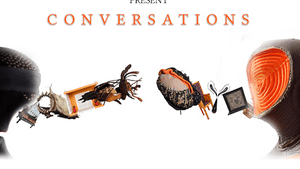Stay in the Loop
BSR publishes on a weekly schedule, with an email newsletter every Wednesday and Thursday morning. There’s no paywall, and subscribing is always free.
An art-to-art conversation
Legend Galleries and Philadelphia Sculptors present 'Conversations'

Imagine artworks in an exhibition as passengers on a train: they occupy the same place at the same time and perhaps have similar destinations. Beyond that, they’re not especially connected. Yet, like strangers taking the 5:35 to Fox Chase, they may talk along the way and discover common threads. Presented by Philadelphia Sculptors at Legend Galleries, Conversations illustrates the idea of reaching common ground through communication.
Themes diverse, but familiar
Curator Marc Blumenthal has selected 26 diverse works and positioned them to encourage cross-consideration among viewers. Given that most of the sculptures were made within the last three years, current ideas are well represented, but timeless themes are also explored.
Works by Elizabeth Heller and Georgette Veeder span this divide. In The Great Escape (2015-2016), Veeder, who is concerned with humans’ impact on the environment, addresses the decimation of bee populations by insecticides. Tiny escape ladders dangle from a papier-mâché hive, all suspended from a huge, twisting branch. Her puckish depiction makes the point: even if the bees’ plight didn’t threaten the worldwide food supply, who wouldn’t want to help the little guys?
Nearby rests Heller’s Dreamer at Low Tide (2016), an upturned face encased in tendrils of polished walnut, plum, mahogany, and found wood, curling like sleepy thoughts on the edge of consciousness. The piece was inspired by beached driftwood on the banks of the Delaware River, which led to images of tree roots and creative thoughts.
Conceptions of home
Fabric artist Mary Olin Geiger’s Imprint: Upside Down (2016) consists of a distressed bedsheet spread over metal innersprings. These elements lie in a heap on the gallery’s parquet floor. The sheet has been stitched in places and burned in others, Geiger’s inverted take on traditional needlework, long considered a feminine hallmark. The more forceful impression, however, is not of stereotypes but of homes lost to calamity, makeshift shelters on the street, or fire-damaged remains tossed to the curb.
Next to Geiger’s work sits Rebecca Epstein’s Paper Palace (2015), which mirrors Imprint’s angular position on the floor. Epstein, using natural materials to minimize her work’s ecological footprint, fashioned a campsite, a lean-to made with paper pulp from local leaves, resting on a foundation of dark brown loam. The peaceful tableau projects harmony between humans and their habitat and practically begs for a cheery campfire.
How we treat one another
David Page’s Stack (2016) speaks volumes. Though just a portion appears here, viewers can watch a video of the full work being assembled. In it, six people, expressionless and blindfolded, are harnessed around the waist and shoulders and hoisted up a wall into two stacks of three. Each person is encased in an orange-and-gray vinyl sarcophagus. A wide hose connects to a bellows which, when pressed, supplies air. It is a suffocating commentary on imprisonment, how societies punish their wayward members, and how methods of retribution can hinder or even preclude reform.
Captivity also preoccupies John Costanza. Though specific to one country, his El Salvador #1 (2014) speaks to the universal experience of being powerless and under siege. Anonymous faces press through a ceramic canvas with the appearance of stone. Clustered together, the unformed faces look less like monument portraits than facial reconstructions made to identify the dead.
Getting from here to there
Every work of art becomes a conversation. First the artist speaks internally, then with her medium, and then with each person encountering the work. The messaging may be imperfect from artist to the world, and it may be influenced by context, as Conversations demonstrates. Art can be misinterpreted or translated in ways the artist never intended. Not every work will speak to every viewer. But when there is a spark of understanding, conversation flows -- and the journey, whether on a train or in a gallery, takes on new meaning.
What, When, Where
Conversations. Through April 2, 2017, at the Legend Galleries, 230 N. 21st Street, Philadelphia. (215) 564-2400 or legendgalleries.net.
Sign up for our newsletter
All of the week's new articles, all in one place. Sign up for the free weekly BSR newsletters, and don't miss a conversation.
